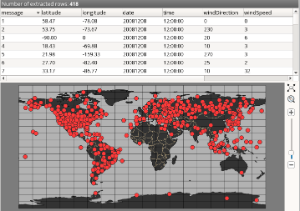...
| Tip |
|---|
These conditions are combined together by the logical AND operator. So a row of data is only added to the results when all the conditions match. |
Sample data
This is the list of the data files used for the examples:set of examples is based on file temp.bufr (click here for details).
| Anchor | ||||
|---|---|---|---|---|
|
...
Extracting a single parameter
This set of examples is based on file temp.bufr (click here for details). This set of examples are based on file temp.bufr (see above).
...
Extracting with a single coordinate condition
This set of examples are is based on file temp.bufr (see aboveclick here for details).
| Example | Filter | Results | Comments | ||
|---|---|---|---|---|---|
For all the messages: extract the first temperature value which is greater than 300 K and also extract the pressure on which it occurs |
| Here we explicitly say the we only want the matching temperature values which appear inside a pressure block (in these messages this is always the case). By using the coordinate condition pressure will be extracted as well because the EXTRACT_COORDINATE option is On by default. | |||
| For all the messages: extract the first temperature value which is greater than 300 K and the pressure is less than 950 hPa |
| Here we further refined the coordinate condition. | |||
| For all the messages: extract the temperature value on the 500 hPa pressure level |
| ||||
For station 78016: extract the temperature on the second pressure level |
| Here we restricted the filter for one station (message) only and used a rank condition for the coordinate. | |||
| For station 78016: extract the temperature on the first 6 pressure levels |
| For coordinate rank a list of values can be specified. | |||
| For station 78016: extract the temperature on the 925, 850 and 700 hPa pressure levels |
|
Extracting multiple parameters
This set of examples are is based on file temp.bufr (see aboveclick here for details).
| Example | Filter | Results | Comments | ||||
|---|---|---|---|---|---|---|---|
For all the messages: extract the first wind speed and wind direction values |
|
| |||||
| For all the messages: extract the first wind speed and wind direction values and also extract their pressure |
| ||||||
| For all the messages: extract wind speed and wind direction values on the 500 hPa pressure level |
|
Extracting with multiple (nested) coordinate conditions
This set of examples are is based on file temp.bufr (see aboveclick here for details).
When we use multiple coordinate conditions these are supposed to conceptually be nested, i.e. there is an inner coordinate and the other, inner coordinates, are nested in it. This puts a constrain on the order the coordinate conditions are specified: the outer coordinate has to be specified first then the other coordinates in the nesting order.
...
Tropical cyclone tracks
This set of examples are is based on file tropical_cyclone.bufr (see above click here for details).
| Example | Filter | Results | ||
|---|---|---|---|---|
For the first message (storm IN-FA) extract the storm centre pressure values along the track for ensemble number =2 |
|
...









